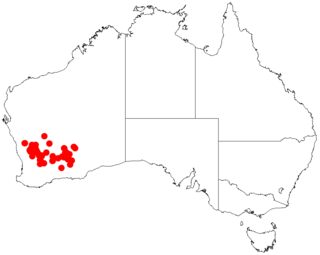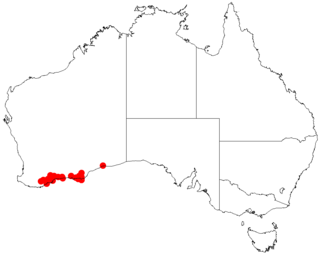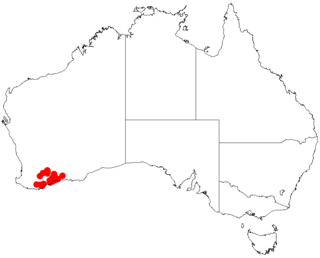
Acacia drepanocarpa is a shrub belonging to the genus Acacia and the subgenus Juliflorae native to northern Australia.
Acacia incongesta, also known as Peak Charles wattle, is a shrub belonging to the genus Acacia and the subgenus Juliflorae that is endemic to a small area in south western Australia

Acacia isoneura is a shrub belonging to the genus Acacia and the subgenus Juliflorae that is endemic to western Australia.

Acacia lirellata is a shrub belonging to the genus Acacia and the subgenus Juliflorae that is endemic to south western Australia.

Acacia neurophylla, also known as wodjil, or broad-leaf wodjil, is a shrub or tree belonging to the genus Acacia and the subgenus Juliflorae that is endemic to south-western Australia.

Acacia oncinophylla, commonly known as hook-leaved acacia, is a shrub belonging to the genus Acacia and the subgenus Juliflorae.
Acacia synoria is a tree or shrub, also known as goodlands wattle, belonging to the genus Acacia and the subgenus Juliflorae that is endemic to a small area of western Australia.

Acacia sphacelata is a shrub of the genus Acacia and the subgenus Phyllodineae that is endemic to south western Australia.

Acacia barrettiorum, commonly known as the Barrett's wattle, is a shrub of the genus Acacia and the subgenus Plurinerves. It is native to an area in the Kimberley region of Western Australia.

Acacia chapmanii is a shrub of the genus Acacia and the subgenus Plurinerves that is endemic to south western Australia.

Acacia deltoidea is a shrub of the genus Acacia and the subgenus Plurinerves that is endemic to north western Australia.

Acacia duriuscula is a shrub or tree of the genus Acacia and the subgenus Plurinerves that is endemic to an area of south western Australia.

Acacia inceana is a shrub or tree of the genus Acacia and the subgenus Plurinerves that is endemic to south western Australia.

Acacia lineolata, commonly known as dwarf myall, is a shrub of the genus Acacia and the subgenus Plurinerves that is endemic to an area of south western Australia.

Acacia nitidula is a shrub of the genus Acacia and the subgenus Plurinerves that is endemic to an area along the south coast of south western Australia.

Acacia spongolitica is a shrub of the genus Acacia and the subgenus Plurinerves that is endemic to south western Australia.

Acacia subsessilis is a shrub of the genus Acacia and the subgenus Plurinerves that is endemic to an area of western Australia.

Acacia tetanophylla is a shrub of the genus Acacia and the subgenus Plurinerves that is endemic to an area of south western Australia.

Acacia triptycha is a shrub or tree of the genus Acacia and the subgenus Plurinerves that is endemic to an area of south western Australia.

Acacia subporosa, also commonly known as river wattle, bower wattle, narrow-leaf bower wattle and sticky bower wattle, is a tree or shrub of the genus Acacia and the subgenus Plurinerves that is endemic to an area of south eastern Australia. It is considered to be rare in Victoria


















